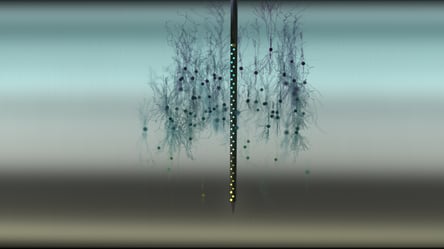Kari Hoffman is the Principal Investigator in the Perception Plasticity & Learning Lab at Vanderbilt University, and studies the neural mechanisms underlying perception and memory formation. As a pioneer in freely-moving recordings, she was an early adopter of the DBC Deep Array due to its ability to record from deep structures in the NHP brain, while providing dense recording sites and enabling single neuron resolution across hippocampal layers.
 Recently, Kari and her student Saman Abbaspoor collaborated with Tyler Sloan at Quorumetrix Studios to create a visual and auditory representation of hippocampal sharp-wave ripples (SWR). The resulting video was awarded 1st Place in the 2023 BRAIN Initiative: Show Us Your BRAINs! Photo & Video Contest titled "Simian Symphony: Ripple Assemblies During Rest".
Recently, Kari and her student Saman Abbaspoor collaborated with Tyler Sloan at Quorumetrix Studios to create a visual and auditory representation of hippocampal sharp-wave ripples (SWR). The resulting video was awarded 1st Place in the 2023 BRAIN Initiative: Show Us Your BRAINs! Photo & Video Contest titled "Simian Symphony: Ripple Assemblies During Rest".
The symphony is based on 256-channel wireless recordings using high-density linear arrays (DBC Deep Arrays). The electrodes span the CA1 layers of a macaque during sleep and breaks from learning in a freely-behaving enclosure. During these states, the CA1 region generated SWRs, at which time synchronized ensembles of units are known to replay sequences of activity from previous experience. These ripple events were extracted together with isolated unit activity that occurred during the ripples. In the video, the unit activity is displayed according to that cell's location in the CA1 layer, and the cell type was selected according to physiological and anatomical features (pyramidal cells, basket cells, and dendritic layer interneurons).
The spike-sorted units were each associated with a unique pitch based on their depth within the hippocampus. Deeper neurons had lower pitches, whereas more superficial neurons had higher pitches. The pitches were mapped to a C-major scale of a midi piano - low-end notes were given the timbre of an acoustic bass, while high-end notes were assigned the timbre of a marimba. In this brief clip, spike units from several confirmed SWRs were shown in sequence. The similarity between SWRs was determined from the unit vectors for each ripple, and they were deemed similar if the units spiked a similar number of times in that ripple epoch. The resulting display gives an impression of the intricate spatiotemporal coordination that is the signature of the SWR, and may account for its presumptive role in forming lasting memories.
The animals in this study performed a sophisticated memory task on two different levels with four touch screens. This was possible because of the wireless recordings.
This recent pre-print from the Hoffman lab by first author Saman Abbaspoor describes the data used to generate the video and results: Theta- and gamma-band oscillatory uncoupling in the macaque hippocampus.
